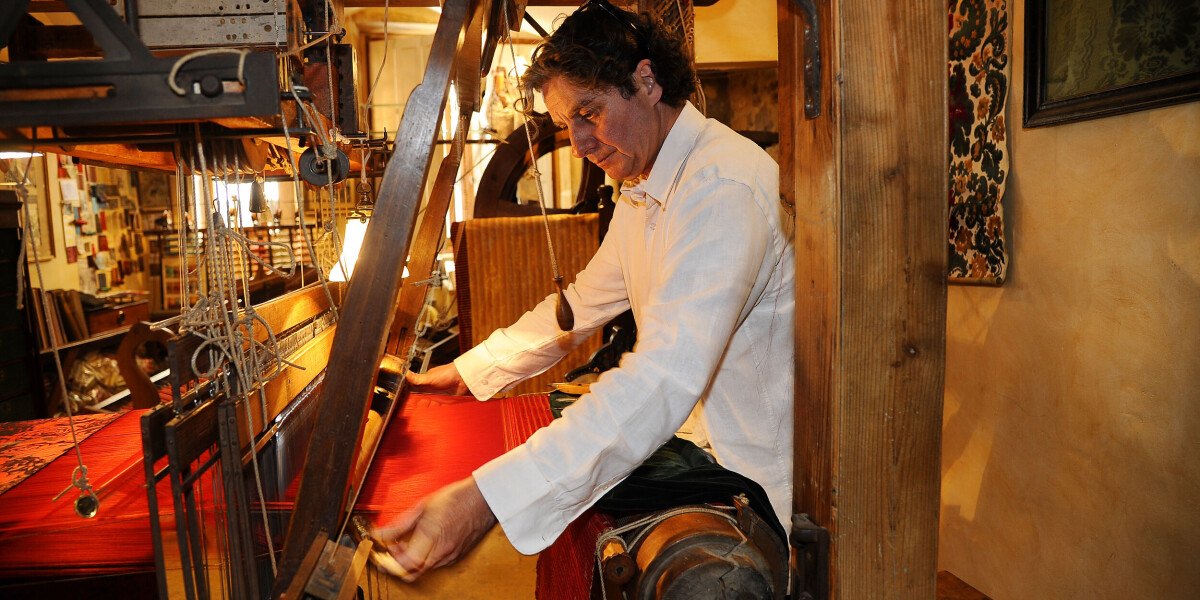
Silk workers weave a spell on lyon’s shoppers and tourists
- Select a language for the TTS:
- UK English Female
- UK English Male
- US English Female
- US English Male
- Australian Female
- Australian Male
- Language selected: (auto detect) - EN
Play all audios:

Lyon’s Saint-Georges silk workshop is not just about soft furnishings and scarves. It tells an important story of the city’s industrial history. It counts itself among Lyon’s oldest
_soieries_ (silk workshops) and is one of the last three to weave fabric on Jacquard looms, the machine invented by Joseph Marie Jacquard to automate patterning that turned Lyon into the
heartland of silk manufacturing in the 19th century. The workshop is situated on rue Mourguet, in one of the oldest parts of Lyon. It is overseen by Romain and Virgile de la Calle, who took
over from their father Ludovic. “Silk fabric and spools – that was my childhood,” says Romain, who remembers playing hide-and-seek between the 1820s looms with his brother. He started
working there seven years ago, having grown disillusioned with his construction job and worried that his father would close the business on retirement if he was unable to find a buyer.
Virgile joined three years ago. ‘LEARNED ON THE JOB’ “We learned on the job,” says Romain, whereas most workers enter the craft with a qualification from the Institut national des métiers
d’art (INMA). Like _canuts_ (Lyonnais silk workers) of old, the brothers use two traditional hand techniques. The first, to weave velvet, requires meticulous attention to produce just two or
three centimetres of fabric a day. The second technique, called _brocart_ (brocade), sees the brothers insert additional weft threads to create ornamental patterns in certain sections of
the fabric, racking up five to seven centimetres a day. To begin, Romain maps out the designs on graph paper, making notes and studying colours to help him design a punch card for the
Jacquard machine, which will control its sequence of operations. ‘LIKE EARLY COMPUTING’ “This is a bit like early computing,” he says. Indeed, the ability to change the pattern of the loom’s
weave by simply changing cards was an important conceptual precursor to the development of computer programming and data entry. Romain will spend the next two months preparing the loom,
from threading it for the ground warp to preparing the bobbins for the pile warp (there can be thousands). Romain believes there are only 10 to 15 people who are still able to work like this
on Jacquard machines, as the expertise has gradually been lost. His father learnt the trade at a silking school and, on graduating, honed his craft among the very last master-weavers in
Lyon’s Croix-Rousse district, the historic home of the city’s canuts. ‘NOSTALGIC’ “It is hard not to feel nostalgic for what Lyon once had,” says Ludovic. The Saint-Georges workshop has seen
seven generations of textile workers pass through, while his previous workshop in Croix-Rousse could trace five generations. Things really took off for the Lyon silk industry in the 15th
and 16th centuries. Around 1540, King Francis I gave Lyon a monopoly on raw silk imports, ensuring that all the fine silk coming into the country from Italy or Asia first stopped in the
city. Italian weavers were also installed in Croix-Rousse around the 16th century, and the industry steadily grew over the years. A 1788 census records Lyon had 14,777 silk looms in 5,832
workshops. The district grew even bigger after the invention in 1804 of the Jacquard machine, which boosted output. REVOLT Soon after, however, in 1831, the _canuts_, all under the
employment of wealthy silk merchants, revolted in protest at their pitiful wages and poor working conditions. They took over the Croix-Rousse district, pushing merchants and military out and
holding on for weeks until the army reclaimed the city and peace was negotiated. Three years later, there was a second revolt. This time the _canuts_ held Lyon for nearly a week, until
12,000 soldiers swarmed in, killing hundreds of workers. The industry faltered, but slowly revived. Saint-Georges has been keen to highlight the part it plays in this long history of silk
weaving. Ludovic had the idea to open the workshop to the public to keep a spotlight on Lyon’s industrial heritage, and the move seems to have paid off. PARTNERSHIP WITH CITY The company has
built partnerships with the city’s tourist office and foreign tour operators, giving it more visibility. There is also a nearby shop on rue Saint-Jean, and collaborations with chateaux to
replace tapestries and soft furnishings in their interiors. Ludovic, who officially retired in January, is justifiably proud of his legacy. “I gave everything that I could in the time I
had,” he says, “and I still come by the workshop to help out, with machine repairs for example. “This is a craft for life.” RELATED ARTICLES THE SCOTTISH BREWER WHO MADE CRAFT BEER IN FRANCE
BEFORE IT WAS TRENDY GOOD GOURD! FRENCH ARTIST TURNS DRIED FRUIT INTO ART STRAIGHT TO THE (NEEDLE) POINT IN ALENÇON, FRANCE
